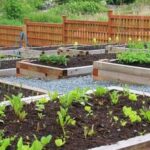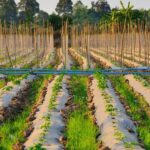Are you thinking about starting a vegetable garden but concerned about pests and critters getting in the way? Look no further.
In this article, we will explore the world of screened in vegetable gardens and why they are a must-have for any gardener. From the benefits of having a screened in garden to the planning, materials needed, and even stunning pictures from real gardeners, you’ll find everything you need to know to get started on your own enclosed garden.
A screened in vegetable garden offers numerous benefits that make it an essential addition to any gardening space. Not only does it provide protection from pests and critters, but it also creates a controlled environment for your plants to thrive. Whether you’re a seasoned gardener or just starting out, a screened in vegetable garden can make all the difference in the success of your crops.
In this article, we will delve into the various aspects of creating and maintaining a screened in vegetable garden. From planning and designing to building and caring for your garden, we will provide a comprehensive guide to help you get started.
Additionally, we’ll showcase stunning pictures from real gardeners who have successfully cultivated their own enclosed vegetable gardens for inspiration. So let’s dive in and discover why a screened in vegetable garden is truly a must-have for any gardening enthusiast.
Benefits of a Screened in Vegetable Garden
A screened in vegetable garden offers a multitude of benefits for both beginner and experienced gardeners. One of the primary advantages is the protection it provides from external threats such as pests, wildlife, and adverse weather conditions. By enclosing your vegetable garden with a screen, you can prevent animals from feasting on your produce and minimize the risk of damage from harsh winds and heavy rain.
Moreover, a screened in vegetable garden creates a controlled environment that allows for better management of soil quality, temperature, and humidity levels. This can result in healthier plants and higher yields, as the enclosed space provides a barrier against unpredictable environmental factors. Additionally, the controlled environment makes it easier to implement organic pest control methods without the need for harmful chemicals.
In addition to protection and control over environmental factors, a screened in vegetable garden also offers a more pleasant gardening experience. Without worrying about pests or wildlife invaders, you can enjoy tending to your plants without constant vigilance. This creates a more relaxing atmosphere for gardeners to engage in their favorite hobby while reaping the benefits of fresh produce. Overall, the numerous benefits make creating a screened in vegetable garden a worthwhile investment for any gardening enthusiast.
Planning Your Screened in Vegetable Garden
When planning a screened in vegetable garden, there are several key factors to consider in order to ensure the success of your garden. One of the most important decisions to make is the size of your garden. Consider the amount of space you have available and how much produce you want to grow. Keep in mind that larger gardens will require more maintenance and upkeep.
In addition to size, it is crucial to carefully select the location of your screened in vegetable garden. Choose a spot that receives plenty of sunlight and has good soil drainage. Avoid areas with strong winds or excessive shade, as this can negatively impact the growth of your vegetables. Additionally, consider proximity to water sources for easy irrigation.
When designing your screened in vegetable garden, think about the layout and organization of your plants. Consider the best way to maximize space and improve accessibility for planting, watering, and harvesting. You may also want to incorporate trellises or support structures for climbing plants such as tomatoes or cucumbers.
As you plan your screened in vegetable garden, don’t forget to seek inspiration from other successful gardeners. Look at pictures of screened in vegetable gardens from real gardeners to gather ideas for design, layout, and plant selection. Taking the time to plan carefully will help ensure a bountiful harvest from your new screened in vegetable garden.
Materials and Supplies Needed for Building a Screened in Vegetable Garden
Building a screened in vegetable garden requires the right materials and supplies to ensure that it is properly constructed and functional. Here are some essential items that you will need to gather before you begin building your own screened in vegetable garden:
Screen Material
The most important component of a screened in vegetable garden is, of course, the screen material itself. You will need to invest in high-quality, durable screen material that can withstand outdoor elements and effectively keep pests out of your garden.
Lumber or PVC Pipes
You will need a sturdy frame to support the screen material. Depending on your preference and budget, you can choose between using lumber or PVC pipes to construct the frame for your screened in vegetable garden.
Hardware and Fasteners
To secure the screen material to the frame, you will need hardware such as screws, nails, staples, and brackets. It’s important to use weather-resistant hardware to ensure that it withstands outdoor conditions.
Door and Hinges
If you want easy access to your vegetable garden, you will need a door with hinges for entry and exit. Make sure that the door is also fitted with screen material to maintain the integrity of the enclosure.
Tools
Lastly, don’t forget about the tools needed for construction such as a saw, drill, hammer, staple gun, and measuring tape. Having the right tools on hand will make the building process much smoother.
By gathering these materials and supplies beforehand, you’ll be well-prepared to begin constructing your very own screened in vegetable garden.
Step-by-Step Guide to Building a Screened in Vegetable Garden
Building a screened in vegetable garden can be a rewarding and beneficial project for any gardening enthusiast. Not only does it provide protection from pests and harsh weather conditions, but it also creates a controlled environment that is ideal for growing healthy and thriving vegetables. In this section, we will provide a step-by-step guide to help you build your own screened in vegetable garden.
Step 1: Choose the Location
The first step in building a screened in vegetable garden is to choose the right location for it. Look for an area in your yard that receives ample sunlight and has good drainage. It should also be easily accessible for watering and maintenance. Consider the proximity to your home as well, as you will want to easily access your garden for harvesting and care.
Step 2: Build the Frame
Once you have chosen the location, it’s time to build the frame of your screened in vegetable garden. You can use materials such as lumber, PVC pipes, or even metal stakes to create a sturdy frame that will support the screens. Make sure to measure and level the frame carefully to ensure that it is sturdy and stable.
Step 3: Install the Screens
After constructing the frame, the next step is to install the screens. You can use wire mesh or nylon netting to create a barrier around your vegetable garden that will keep out insects and small animals. Be sure to secure the screens tightly to prevent any gaps that could allow pests to enter.
By following these steps, you can successfully build your own screened in vegetable garden and enjoy all the benefits of growing healthy and organic produce right in your backyard. With careful planning and construction, you can create a thriving garden that will provide you with an abundant harvest for years to come.
Top Vegetables to Grow in a Screened in Garden
When it comes to deciding which vegetables to grow in your screened in vegetable garden, there are several factors to consider. You will want to choose vegetables that thrive in a protected environment and can withstand the potential challenges of being grown behind a screen. Here are some top vegetables that are well-suited for growing in a screened in garden:
- Tomatoes: These popular garden favorites do well in a screened environment, as they benefit from protection against pests and diseases.
- Peppers: Whether sweet bell peppers or spicy chili peppers, these plants can thrive in a screened area with plenty of sunlight.
- Cucumbers: With the right support for their vines, cucumbers can produce an abundance of crisp, fresh fruits within the confines of a screened garden.
- Zucchini: This versatile summer squash is a great choice for a screened garden, as it requires consistent moisture and protection from pests.
- Lettuce and Leafy Greens: These fast-growing crops are ideal for a screened environment, as they can be easily protected from pests and harsh weather conditions.
These are just a few examples of the many vegetables that can thrive in a screened in vegetable garden. By choosing the right plants and providing them with the necessary care and attention, you can enjoy a bountiful harvest of fresh, home-grown produce.
Remember to consider your local climate and growing conditions when selecting vegetables for your screened garden. Some plants may require specific temperatures or sunlight exposure to thrive, so be sure to choose varieties that are well-suited to your specific location.
Whether you’re an experienced gardener or new to the world of vegetable gardening, growing your own produce in a screened environment can be incredibly rewarding. With the right plants and proper care, you can create a lush and productive oasis that provides you with an abundance of fresh, healthy vegetables throughout the growing season.
Maintenance and Care Tips for a Screened in Vegetable Garden
Maintaining and caring for a screened in vegetable garden is essential to ensure a bountiful harvest and to keep plants healthy. Here are some tips to help you keep your garden in top shape:
1. Regular Inspection: It’s important to regularly inspect your screened in vegetable garden for any signs of pests, diseases, or other issues. Check the leaves, stems, and fruits of your plants for any abnormalities and take action to address them promptly.
2. Watering: Proper watering is crucial for the health of your vegetables. Be sure to water your plants thoroughly, making sure that the soil is moist but not waterlogged. Consider installing a drip irrigation system to ensure that your plants receive a consistent supply of water.
3. Fertilizing: Provide your vegetables with the nutrients they need by fertilizing them appropriately. Use organic fertilizers or compost to avoid chemical buildup in the soil, which could affect the flavor and safety of your produce.
4. Pruning and Trellising: Some vegetables, such as tomatoes and cucumbers, benefit from pruning and trellising to encourage healthy growth and maximize space in your garden. Keep an eye on these plants and provide support as needed.
5. Pest Control: Despite being screened in, pests can still find their way into your garden. Regularly check for signs of insect damage and use natural pest control methods whenever possible to protect your crops without harming beneficial insects.
By following these maintenance and care tips, you can enjoy a successful growing season in your screened in vegetable garden while ensuring that your produce is healthy, safe, and delicious.
Inspiration
In conclusion, adding a screened-in vegetable garden to your outdoor space is not only practical but also visually appealing. The benefits of having a protected area for your vegetables to thrive are plentiful, and the planning and building process can be well worth the effort.
By incorporating the right materials and supplies, selecting the best location, and following a step-by-step guide, you can create a beautiful and functional screened-in garden that will provide you with an abundant harvest.
When it comes to maintenance and care, implementing simple tips will ensure that your screened-in vegetable garden remains healthy and productive. From regular watering to pest control measures, staying on top of these tasks will help you maintain a thriving garden throughout the season. Additionally, choosing the right vegetables to grow in your screened-in garden based on sunlight requirements and space constraints can further enhance its productivity.
Finally, if you’re seeking inspiration for your own screened-in vegetable garden project, look no further than real gardener’s stunning pictures of their own creations. These visuals can provide valuable insights into design ideas, creative layouts, and innovative ways to maximize space.
Whether it’s vertical gardening or integrating decorative elements into the garden, these pictures can serve as a rich source of ideas for your own unique vision. With careful planning and dedication to maintenance, you too can achieve a flourishing and picturesque screened-in vegetable garden in your own backyard.
Frequently Asked Questions
What Is a Good Layout for a Vegetable Garden?
A good layout for a vegetable garden typically involves organizing the plants in rows or blocks, with easy access to walk between them for planting, weeding, and harvesting. It’s important to consider sunlight exposure and spacing between plants to optimize growth.
Should I Enclose My Vegetable Garden?
Enclosing a vegetable garden can be beneficial if you have issues with pests or wildlife damaging your crops. A fence or netting can help keep out animals like rabbits, deer, or birds. Just make sure there is enough airflow and sunlight for your plants.
How Do You Cover a Garden With Netting?
When covering a garden with netting, it’s important to first secure the netting tightly over the garden area using stakes or hooks. Make sure the netting is taut and doesn’t sag too much to prevent pests from getting through. Be mindful of any plants that might grow taller and need extra space under the netting.

If you’re looking to get into vegetable gardening, or are just looking for some tips on how to make your current garden better, then you’ve come to the right place! My name is Ethel and I have been gardening for years. In this blog, I’m going to share with you some of my best tips on how to create a successful vegetable garden.





